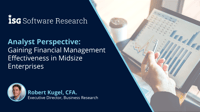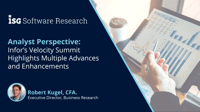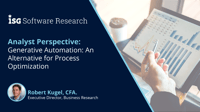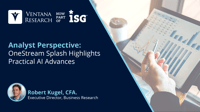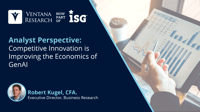Doing more with less is the defining characteristic of finance and accounting departments in midsize enterprises, which ISG research defines as organizations with between 100 and 999 workers. One frustrating truth confronting executives in these organizations is that, once their company stops being a small business, it has many of the same challenges that large enterprises face but with fewer resources to deal with them. Over the past two decades, advances in information technology have had the...
Read More
Topics:
Office of Finance,
Business Planning,
ERP and Continuous Accounting,
natural language processing,
digital finance,
Generative AI,
Procure-to-Pay,
Consolidate and Close Management
I recently attended Infor’s Velocity Summit, designed to showcase the latest versions of its CloudSuite ERP software. Also center stage were Infor’s advances in artificial intelligence and process mining as well as its environmental, social and governance application and supply chain optimization enhancements.
Read More
Topics:
Office of Finance,
ERP and Continuous Accounting,
natural language processing,
digital finance,
Sustainability Management,
AI & Machine Learning,
Continuous Supply Chain & ERP,
Generative AI
Artificial Intelligence and generative AI are beginning to change how enterprises do many things, especially planning and budgeting. This technology has the potential to significantly redefine the mission of the financial planning and analysis group. It will do so by substantially reducing the time spent on the purely mechanical aspects of day-to-day tasks. AI is also making it easier for executives and managers to rapidly forecast, plan and analyze to promote deeper situational awareness and...
Read More
Topics:
Office of Finance,
Analytics,
Business Planning,
Workforce Management,
digital finance,
Revenue Management,
AI and Machine Learning
Agents are all the rage—and for a good reason. They are a way to automate work almost effortlessly so that repetitive and boring tasks get done with the least amount of effort on the part of the operator. In business, agents can be a boon for customer satisfaction and a way to improve worker productivity. They are alluring, with an almost unlimited number of potential use cases.
Read More
Topics:
Office of Finance,
Business Planning,
ERP and Continuous Accounting,
natural language processing,
digital finance,
Work Management,
Generative AI,
AI and Machine Learning,
Digital Applications,
Procure-to-Pay,
Order-to-Cash,
Consolidate and Close Management
Artificial intelligence-enabled business applications have advanced considerably over the past year as software providers have added a steady stream of capabilities. This includes customer facing, financial, supply chain and workforce software. ISG Research asserts that by 2027, almost all providers of business applications will use some form of generative AI to enhance capabilities and functionality to remain competitive.
Read More
Topics:
Office of Finance,
Business Planning,
ERP and Continuous Accounting,
digital finance,
Revenue, Lease and Tax Accounting,
Purchasing/Sourcing/Payments,
Consolidate/Close/Report,
Consolidate and Close Management
Prophix launched its Prophix One platform earlier this year. CFOs of midsize enterprises should take a look at it because it supports a more effective approach to finance and accounting operations in growing companies. It facilitates the transition of organizations that can no longer make do with work-arounds of existing systems to those with formal, controlled core processes that can be completed faster with reduced risk. The platform performs financial consolidation, account reconciliation...
Read More
Topics:
Office of Finance,
Business Planning,
ERP and Continuous Accounting,
digital finance,
AI and Machine Learning,
Consolidate and Close Management
ERP systems have been the central nervous system of enterprises for more than three decades, handling business-critical process management and recordkeeping. While their basic outlines are unchanged, today’s systems are far more capable in their functional depth, adaptability, usability and manageability. Especially for cloud-based systems, they are far easier to maintain. Decades of refinement and focused development to support specific industries, and even specialized categories within these...
Read More
Topics:
Office of Finance,
ERP and Continuous Accounting,
digital finance,
Generative AI,
Procure-to-Pay,
Order-to-Cash
OneStream offers a platform designed to serve the needs of accounting and financial planning and analysis (FP&A) organizations. The software handles financial close and consolidation, planning and budgeting, analysis and reporting. OneStream recently held its annual user conference, Splash, in Las Vegas. In attending this meeting, my focus was on progress the company has made in the areas of predictive artificial intelligence (AI) and generative AI (GenAI) over the past year, since the...
Read More
Topics:
Performance Management,
Office of Finance,
Business Planning,
ERP and Continuous Accounting,
digital finance,
Generative AI,
AI and Machine Learning,
Digital Applications,
Consolidate and Close Management
Improving data management is at the forefront of my Office of Finance research practice because, when not managed well, it can have a profoundly negative impact on departmental efficiency, individual performance, organizational agility and sustainability. Conversely, straight-through processing (STP), a business process design and data management methodology, reduces process friction throughout an organization and, by minimizing errors, builds trust in the accuracy and reliability of all data,...
Read More
Topics:
Office of Finance,
ERP and Continuous Accounting,
digital finance,
Procure-to-Pay,
Order-to-Cash
At this stage of the development of Generative AI, there’s much we can see clearly (at least we think we can), but there’s even more likely to surprise us. As that great 20th-century philosopher and hall-of-fame catcher, Yogi Berra, famously said, “It’s tough to make predictions, especially about the future.” The breadth and speed of innovation today in all aspects of GenAI rivals that of the internet in the 1990s, and for the same reason.
Read More
Topics:
Office of Finance,
ERP and Continuous Accounting,
digital finance,
Generative AI,
Model Building and Large Language Models,
Procure-to-Pay,
Order-to-Cash
